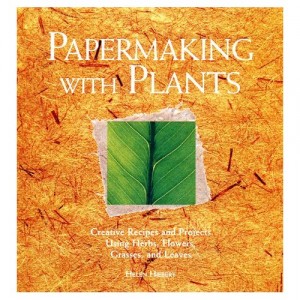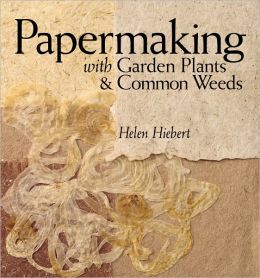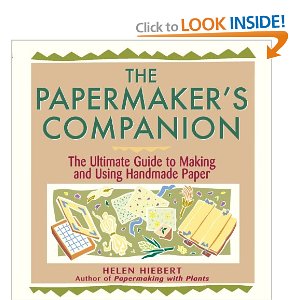On Writing Books
I have to admit that, for the most part, I hated writing in highschool and college. So when I received a letter from an editor at Storey Publishing in 1997, asking whether I’d be interested in writing a book about making paper from plants, I had to think twice about it! I ended up saying yes and was surprised at how much I enjoyed writing (and learning) about something I was passionate about.

Papermaking With Plants, the first edition was hard cover
Yes, I was extremely fortunate. I realize that many/most? writers spend years looking for a publisher. This particular editor at Storey had just become an acquisitions editor, which meant that she had to acquire a certain number of books each year. She was on the look-out! At that time, Storey Publishing was branching into craft books (from gardening and farming – books about practical living). So when she saw a one paragraph description about a class I was offering at the NY Horticultural Society called Compost Papermaking, she thought that would make an interesting book. It was as simple as that.
After she contacted me, I had to go through the typical proposal process (writing an outline, discussing the competition, etc.). Then I was invited to Massachusetts to meet with my editor and discuss the project. I remember her asking me how I would approach the writing process; I remember having no idea, but I don’t recall my response to her. She made a suggestion, and we kept talking (phew). This book was a huge research project for me. I’d really only dabbled in making paper from compost, so I had to interview many colleagues and experts in the field. One of the things I loved about another craft book that Storey had published was that the author had included short stories about artists working in her medium. This is something I adopted and continue to do in each of my books.
When it rains it pours. Just prior to the Storey editor contacting me, another publisher (who shall remain nameless) called the papermill where I was working. She was looking for a potential author for a book on paper lampshades. Coincidentally, I had spent the past year or so teaching myself how to make traditional lamps and experimenting with innovative ways of working with paper and light. I got that contract as well, but after meeting the first deadline, the project was cancelled due to poor sales performance by other books in the series. This was a huge disappointment, since I’d basically developed a framework for the entire book by that point. There is a happy ending to this story though, which I’m saving for part two of this post.

The paperback version, with the same content and an updated cover and title.
To wrap up part one, my editor at Storey called me after I’d finished writing Papermaking With Plants to ask whether I knew anyone who might be interested in writing a book to go with a companion series they had: The Candlemaker’s Companion, The Soapmaker’s Companion… I told her to look no further, I was interested in the project! The Papermaker’s Companion was born. That book was more up my alley in terms of writing, because I’d actually practiced most of the techniques I wanted to write about (basic papermaking techniques, followed by creative two- and three-dimensional techniques for working with paper).

The Papermaker’s Companion
This book came out in the year 2000, and I’m delighted that people are still telling me they use it as a text book in their classrooms and as a resource in their studios. I made my film, The Papermaker’s Studio Guide in 2012 (with the support of funds from the Celebration Foundation and IAPMA) to bring the techniques in the book (shown in black and white) to life.
I’ll write more about my other books in part two of this post next week, but in the meantime, if you’ve used The Papermaker’s Companion, I’d love to know if you have comments or criticism. There is a possibility that it will be revised and printed in full color, and your feedback would be valuable! What is missing? What could be improved? What could be added? Please leave a comment below, and thanks!

6 Comments
Your book is my major source of information. Thanks for sharing your knowledge and inspiration.
Thank you, Wendy!
Great post, Helen. I love how you run with inspiration.
Thanks, Margaret :). That is so true… even in writing that post. I was fumbling around yesterday trying to come up with something, and that is what came to me.
i was so glad when papermaking with plants was published. and i still love the format you used. i actually refer to both books on occasion, and recommend them to my students. the companion is a good text, and i can imagine it being very helpful for setting up a mill. but i particularly love papermaking with plants.
If you are when you are interested in learn about the production of paper, its history, materials, methods and tools, this book is for you. It is well written, well illustrated, instructive and interesting. I wrote an essay for the company https://essaywriters.nyc/
she helped me very much. It is definitely recommended for all who are interested in paper production!